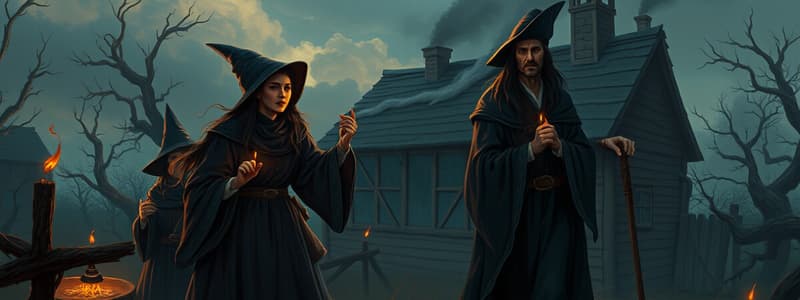Podcast
Questions and Answers
What social factors contributed to the instability in Salem Village prior to the witch trials?
What social factors contributed to the instability in Salem Village prior to the witch trials?
Economic strife, property disputes, and existing rivalries contributed to the instability.
What was the primary basis for accusations of witchcraft during the Salem witch trials?
What was the primary basis for accusations of witchcraft during the Salem witch trials?
Accusations were often based on spectral evidence, or testimony regarding the spirit of the accused.
How did public opinion influence the conclusion of the Salem witch trials?
How did public opinion influence the conclusion of the Salem witch trials?
Public opinion shifted against the trials, leading Governor William Phips to declare a stop to the proceedings.
What legislative changes arose as a consequence of the Salem witch trials?
What legislative changes arose as a consequence of the Salem witch trials?
In what ways did the legacy of the Salem witch trials manifest in American culture?
In what ways did the legacy of the Salem witch trials manifest in American culture?
What role did religious fervor play in the events of the Salem witch trials?
What role did religious fervor play in the events of the Salem witch trials?
What cautionary message do the Salem witch trials convey about mass hysteria?
What cautionary message do the Salem witch trials convey about mass hysteria?
How has the term 'witch hunt' evolved in its usage since the 17th century?
How has the term 'witch hunt' evolved in its usage since the 17th century?
Flashcards are hidden until you start studying
Study Notes
Historical Context
- Location: Salem Village (now Danvers, Massachusetts), 1692.
- Cultural Background: Puritan beliefs dominated, emphasizing strict moral codes and a fear of the devil.
- Social Tensions: Economic strife, property disputes, and existing rivalries contributed to societal instability.
- Initial Accusations: Began in January 1692 with a group of young girls exhibiting strange behaviors, leading to accusations of witchcraft.
- Legal Framework: Massachusetts Bay Colony lacked a formal legal structure for witchcraft; accusations were often based on spectral evidence (testimony that the spirit or specter of the accused was seen committing witchcraft).
Aftermath and Legacy
- Trials and Executions: Over 200 people accused; 30 found guilty, 19 executed (14 women, 5 men), and 5 died in jail.
- End of Trials: By May 1693, the trials ended as public opinion shifted against them, leading to governor William Phips declaring a stop to the proceedings.
- Post-trials Reflection: In 1697, Massachusetts General Court declared a day of fasting and soul-searching for the tragedy of the trials.
- Legacy: The trials became a cautionary tale about mass hysteria, scapegoating, and the dangers of extremism, leading to reforms in legal practices regarding evidence and trials.
Sociopolitical Impact
- Fear of Authority: The trials highlighted the dangers of unchecked governmental power and the consequences of a society driven by fear.
- Religious Influence: Demonstrated how religious fervor could lead to persecution and societal breakdown.
- Legal Reforms: Resulted in changes to legal standards, emphasizing the importance of due process and protection against wrongful accusations.
- Cultural Representation: Continues to influence literature, theater, and popular culture, reflecting themes of paranoia and injustice (e.g., Arthur Miller's "The Crucible").
- Modern Witch Hunts: The term "witch hunt" has become a metaphor for unfair persecution in contemporary contexts, illustrating the trials' enduring relevance.
Historical Context
- Salem Village, now called Danvers, Massachusetts, was the setting for the witch trials of 1692.
- Dominated by Puritan beliefs, the community upheld strict moral codes and harbored a significant fear of the devil.
- The environment faced social tensions driven by economic hardship, property disputes, and existing rivalries, which fueled instability.
- The witchcraft accusations originated in January 1692 as a group of young girls displayed unusual behaviors, sparking widespread claims of witchcraft.
- The Massachusetts Bay Colony had no formal legal framework addressing witchcraft; thus, many accusations relied on spectral evidence—claims that the spirit of the accused harmed others.
Aftermath and Legacy
- More than 200 individuals were accused of witchcraft; 30 were convicted, leading to 19 executions (14 women and 5 men) and 5 deaths in prison.
- The witch trials concluded by May 1693 when changing public opinion prompted Governor William Phips to halt the proceedings.
- In 1697, the Massachusetts General Court acknowledged the tragedy of the trials by declaring a day of fasting and reflection.
- The Salem witch trials serve as a cautionary example of mass hysteria, scapegoating, and extremism, prompting reforms in how evidence and trials are conducted.
Sociopolitical Impact
- The trials revealed the dangers of unchecked governmental authority and showcased the repercussions of a fear-driven society.
- They illustrated the potential for religious fervor to incite persecution and disrupt social order.
- Legal reforms emerged from the trials, promoting due process and providing safeguards against wrongful accusations.
- Literature, theater, and popular culture, such as Arthur Miller's "The Crucible," continue to draw inspiration from them, emphasizing themes of paranoia and injustice.
- The concept of a "witch hunt" has evolved to symbolize unfair persecution in modern contexts, highlighting the trials' lasting significance.
Studying That Suits You
Use AI to generate personalized quizzes and flashcards to suit your learning preferences.




